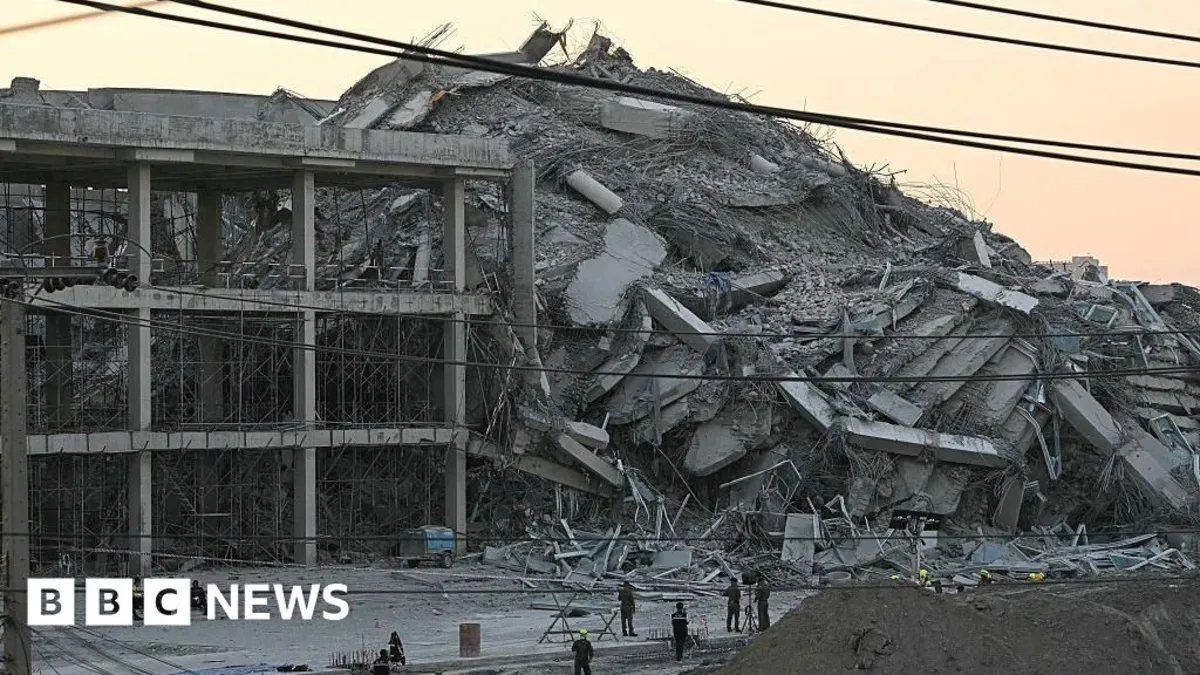
As dusk settles over Bangkok, the scene of devastation at a collapsed 30-storey skyscraper has drawn hundreds of rescue workers, all striving to locate survivors amidst the wreckage. The skyscraper, which was under construction in Thailand's capital, crumbled to the ground, leaving behind a scene that is difficult to comprehend. The rescue teams are focused on reaching approximately 81 workers who are believed to be trapped beneath the rubble of this unfortunate incident.
Witnessing the chaos from a nearby bridge, reporters, including myself, are left in shock as we observe the towering piles of concrete reduced to just three storeys. Twisted wire and metal debris are scattered throughout the area. Despite the arrival of professional rescue teams and military personnel, coupled with the installation of floodlights, the prospect of finding survivors diminishes by the minute. The collapse was triggered by a shallow magnitude 7.7 earthquake that struck central Myanmar, followed shortly by a 6.4 aftershock. These tremors were felt across the border in Thailand, leading to widespread panic and confusion among the residents.
Many locals are grappling with the aftermath of this natural disaster, an experience that is unfamiliar for most. I was at home when the tremors began, and it felt like nothing I had ever encountered before. The building, which belonged to the national audit office, had been under construction for three years, with a budget exceeding two billion Thai baht (approximately £45 million), and now it lies in ruins.
At the perimeter of the site, white tents have been set up as rescue workers, donned in bright yellow hard hats, work tirelessly to free those still trapped. Thai Defence Minister Phumtham Wechachai has confirmed that three individuals have lost their lives due to the collapse. Just under an hour ago, I witnessed the somber sight of two covered bodies being transported to the tents, further highlighting the tragedy of this event.
The road adjacent to the collapsed structure is congested with fire engines, ambulances, and various rescue vehicles, all contributing to the urgent response. Curious onlookers have gathered on the bridge, hoping to gain insight into the unfolding situation. Heavy machinery, including a large crane, has begun to arrive on-site as rescue teams express the need to clear debris before they can commence their search for the missing.
Having arrived less than an hour post-collapse, I encountered several construction workers covered in dust and visibly shaken. One worker, Adisorn Kamphasorn, an 18-year-old, recounted his experience: he was transporting materials from the sixth floor when he felt the tremor. Realizing the impending danger, he ran for his life. "It took one minute for it to collapse. All of a sudden, there was smoke everywhere, and everything went black. I couldn't breathe. I didn't have a mask," he shared, his voice trembling with emotion. Adisorn was unable to contact his family, having lost his phone in the chaos, and expressed his fears of mortality during the incident.
The construction crew comprised a mix of Thai and Burmese workers. Another survivor, Nukul Khemutha, 30, was on the fifth floor when he experienced the tremors. He observed the floors sinking and recalls one of his colleagues who had gone to the tenth floor just moments before the collapse. "We were all just screaming 'run' and urging each other to hold hands and escape," he said. Upon speaking to the group, they appeared despondent, sitting together and smoking to alleviate their anxiety. Unfortunately, none of the survivors had received medical assistance as the focus remained on rescuing those trapped beneath the debris.
As the sounds of drilling echo through the night, the rescue workers brace themselves for what promises to be a long and challenging night. With every passing moment, the urgency of their mission becomes increasingly apparent, as hope for finding survivors begins to wane. The community stands united in its support, as Thailand copes with the aftermath of this devastating disaster.
Additional reporting by Rachel Hagan in London.